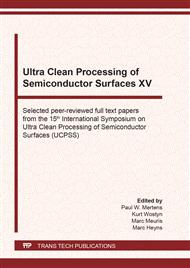p.218
p.222
p.228
p.237
p.247
p.253
p.259
p.264
p.270
Effect of Viscosity on Ceria Abrasive Removal in the Buffing CMP Process
Abstract:
In chemical mechanical planarization (CMP) processes, ceria is generally used as the abrasive . After the CMP process, many ceria particles adhere to the wafer surface and must be removed prior to subsequent processing. In this study, the effect of varied viscosity was investigated during the buffing CMP process for ceria particle removal. After contaminating the wafer surface with ceria slurry, the ceria particles were removed through the buffing CMP process. The wafer surface was analyzed through inductively coupled plasma mass spectrometry (ICP-MS) to confirm cleaning efficiency. The ICP-MS data showed that, as buffing CMP solution viscosity increased, cleaning efficiency improved. These results suggest that increasing the viscosity of the buffing CMP solution improves its effectiveness in removing ceria particles.
Info:
Periodical:
Pages:
247-252
Citation:
Online since:
February 2021
Authors:
Keywords:
Price:
Сopyright:
© 2021 Trans Tech Publications Ltd. All Rights Reserved
Share:
Citation:


